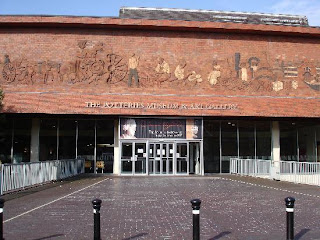Arthur Berry wasn't a great supporter of urban renewal. In his famous lament for the lost pubs of Burslem the artist, playwright and broadcaster speaks fondly of gaunt, dark buildings discoloured by years of wet smoke and complains that nothing has been the same since they were knocked down. Travelling though the Potteries today it's impossible not to share a little of Berry's nostalgia as entire neighbourhoods disappear from the map. Following years of decline no-one would deny that change is overdue but regeneration was never going to be painless and this conflict is reflected in an art project currently underway in the city.
Place, Space and Identity was initially conceived as part of the RENEW North Staffordshire programme with the aim of bringing creativity to the area's urban renaissance and extending the opportunity for participation in the arts . In its third phase it is overseeing public art projects in a number of areas designed to confront our industrial heritage and provoke discussion about the future aspirations of the city. One of these areas is Middleport.
Over the past weeks Anoushka Athique has been carrying out repairs to clothing in return for residents memories. Taking these stories as a starting point her intervention into the urban landscape takes the form of a route wrapped in fabric around the streets and parks of this once thriving community . Before continuing I must declare something of a personal interest here. My parents grew up in Middleport and so did their parents before them so perhaps I might add a few memories of my own as we follow the Fabric Walk.
Like many journeys it begins at a station before continuing alongside the long closed Railway pub and already I find myself scanning the landscape for the distinctive purple fabric that will guide my next step. Crossing the road I pass another sadly neglected boozer where, in the early 80s, they served chicken in a basket and teenage girls drank lager and black. I'm travelling back in time and heading towards the canal.
Following the wrapped tow path I'm reflecting on the role of canals as the arteries of the industrial revolution when a barge approaches causing the fabric to ripple in the swell and I'm reminded how filthy this canal was when I was a child - a foul polluted waterway full of old prams and bikes - and how much better it is today as a site for boating and pleasant strolls. Change shouldn't be measured solely on what we lose. We must also take into account what we gain as a result.
Crossing the partially wrapped bridge into Middleport proper it strikes me how the experience is causing me to look at things differently. I'm no longer simply a stroller I'm attuned to the unexpected, to the psycho-geography, the derive. Once into familiar surroundings the full impact of the regeneration programme on the area becomes apparent. Whole streets are boarded up awaiting demolition while many have disappeared altogether. Following the fabric adorning the railings of the park where my grandmother liked to sit I notice the dilapidated club that was once at the heart of the community. Another derelict drinking den I think to myself. Arthur Berry would not be pleased.
Anoushka Athique says one of the ideas the Fabric Walk explores is that sewing, wrapping and repairing are inherently caring and restorative actions and nowhere is this more apparent than in the lovingly wrapped individual bricks sitting on a demolition site. Equally touching is a nearby sign bearing the name of a street that no longer exists bandaged in the now familiar purple fabric. But it isn't only the bricks and mortar I imagine being cared for as I look around but all the qualities that once made up this community and which must be preserved if it is to be reborn.
For a moment I think I've reached the end of the walk but something tells me it can't end at this spot. That would be too desolate, too sad, and so I press on and it's not long before I'm back on track heading into an unexpected green space which may once have been scarred by industrial debris but was long ago returned to nature. On this early autumn afternoon there are people walking dogs and relaxing in the sunshine and the contrast to the blighted streets I've left behind couldn't be more pronounced.
Amid all this greenery my thoughts turn to renewal and as I head up to the highest point overlooking Middleport and Berry's beloved Burslem I'm reminded once again of his opposition to change. If he'd had his way the Potteries would have remained the dirtiest city on the planet to which, he imagined, tourists would flock to marvel at the soot and the grime. Well that was never going to happen but - in respect to Berry's generation, to the memory of my grandparents who lived and worked in these streets and to the younger generation that will repopulate them - we must ensure that this opportunity to build a better future is not wasted.
Retracing my steps along part of the Fabric Walk I'm pleased I took the time to explore it. There are no Reichstags or Pont-Neufs -although as we have seen there is a partially wrapped canal bridge - but these economies of scale are entirely sympathetic to the environment. What's more it demonstrates that Place, Space and Identity is fulfilling its mandate. Evidence from cities that have undergone similar transformations suggests that the arts have a significant role to play in the process, both in offering creative solutions and developing vibrant communities. Let's hope they are given further opportunities to do so in the Potteries.
To find out more about the Fabric Walk and Place, Space and Identity's other public art projects visit www.placespaceidentity.org/


















